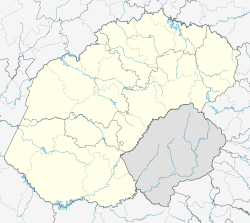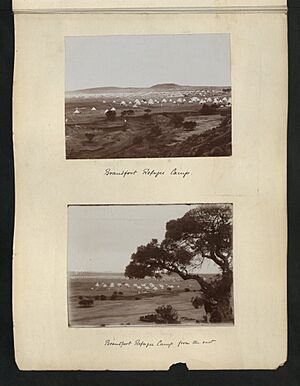Brandfort facts for kids
Quick facts for kids
Brandfort
Winnie Mandela
|
|
|---|---|
| Country | South Africa |
| Province | Free State |
| District | Lejweleputswa |
| Municipality | Masilonyana |
| Established | 1875 |
| Area | |
| • Total | 27.1 km2 (10.5 sq mi) |
| Population
(2011)
|
|
| • Total | 3,143 |
| • Density | 115.98/km2 (300.4/sq mi) |
| Racial makeup (2011) | |
| • Black African | 52.3% |
| • Coloured | 1.9% |
| • Indian/Asian | 0.7% |
| • White | 45.1% |
| • Other | 0.0% |
| First languages (2011) | |
| • Afrikaans | 49.1% |
| • Sotho | 33.4% |
| • Xhosa | 6.7% |
| • Tswana | 4.1% |
| • Other | 6.7% |
| Time zone | UTC+2 (SAST) |
| Postal code (street) |
9400
|
| PO box |
9400
|
| Area code | 051 |
Brandfort, officially renamed Winnie Mandela in 2021, is a small farming town in the central Free State province of South Africa. It is located about 60 kilometers northeast of Bloemfontein on the R30 road. The town provides supplies and services to the farms around it. Brandfort is famous for being the place where Winnie Mandela, an important anti-apartheid activist and wife of Nelson Mandela, lived during her banishment.
Contents
History of Brandfort
The town of Brandfort began in 1866 on a farm called Keerom. This farm was owned by Jacobus van Zijl, a leader of the Voortrekkers (early Dutch-speaking settlers). The President of the Orange Free State at the time, Johannes Brand, visited the community. Soon after, the settlement was named in his honor. Brandfort officially became a town in 1874.
During the Second Anglo-Boer War (1899-1902), the British built a concentration camp here. This camp held Boer women and children. There was also a separate camp for Black people. Brandfort was also home to Hendrik Verwoerd, a former prime minister who helped create apartheid. He finished school in Brandfort.
Important Places in Brandfort
What were the Concentration Camps?
Concentration camps were first used in Cuba in 1896. In South Africa, the first camps were set up in early 1901 during the Anglo-Boer War. Thousands of women and children were taken from their homes and moved into these camps.
Life in the concentration camps was very hard. There were too many people, and not enough food or supplies. Many people got sick and died because of poor nutrition and diseases.
Even during the war, people were kept separate. There was a camp for white people called Dwyersdorp. Next to it was a camp for Black people called Nooitgedacht.
The cemetery for the camp was made a National Monument in 1985. It is now a Provincial Heritage Site. It holds the remains of 1263 women and children. The cemetery was opened on September 22, 1962.
Winnie Mandela's Banishment House
Winnie Mandela, a brave anti-apartheid activist and former wife of Nelson Mandela, was sent to Brandfort in May 1977. This was known as banishment. She lived at house number 802 in the Black township of Brandfort. The area had no running water or electricity. When she moved in, the house also had no floors or ceilings.
In a book about her life, Winnie Mandela described Brandfort as:
"A drab and dusty rural hamlet with unimaginative houses, an old-fashioned two-storey hotel, small shops lining the main street and a pervading atmosphere of lethargy and inactivity… The forlorn township had no official name but the black residents had baptised it “Phathakahle” meaning handle with care"
This house is now being considered as a National Heritage Site. There are plans to turn it into a museum.
Brandfort's Economy Today
Brandfort's economy has changed a lot over the years. In the past, it was known for its good schools and many businesses. It had agricultural co-operatives and good health services. There were also sports facilities, a caravan park, and a hotel.
Today, many of these facilities are not well-maintained. The museums and monuments are showing signs of age. There isn't a clear plan yet to save them from further decay.
The Admiral John Weston House Museum is now under new management. The house is being renovated. It is open to the public, and you can visit for free. Schools often arrange educational trips there.
Many people in Brandfort rely on government support to live. Only a small number of people have full-time jobs.





